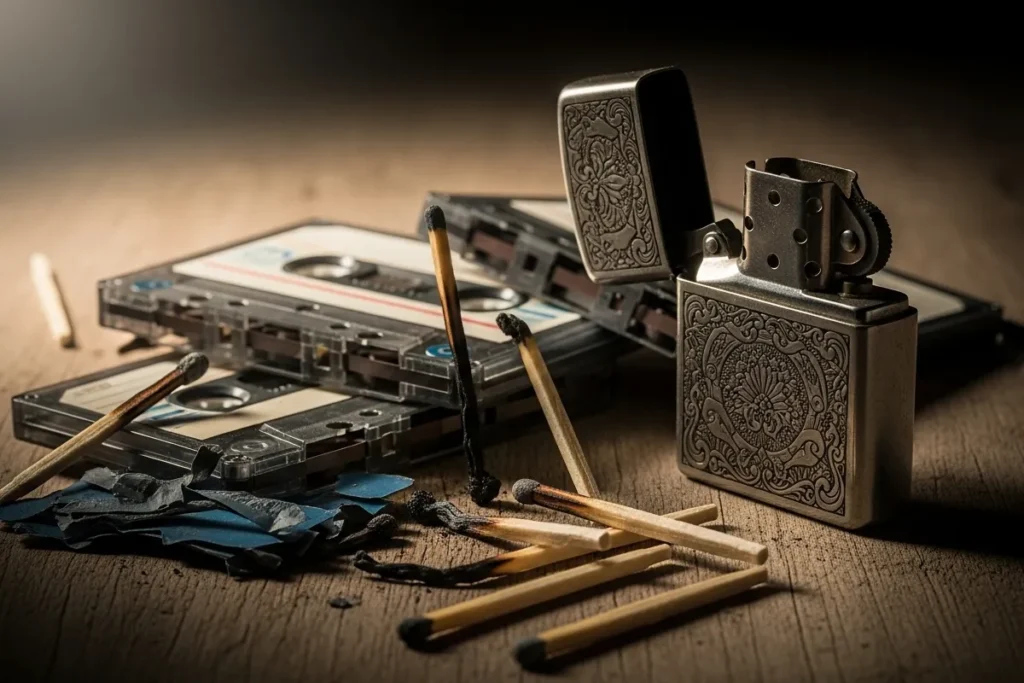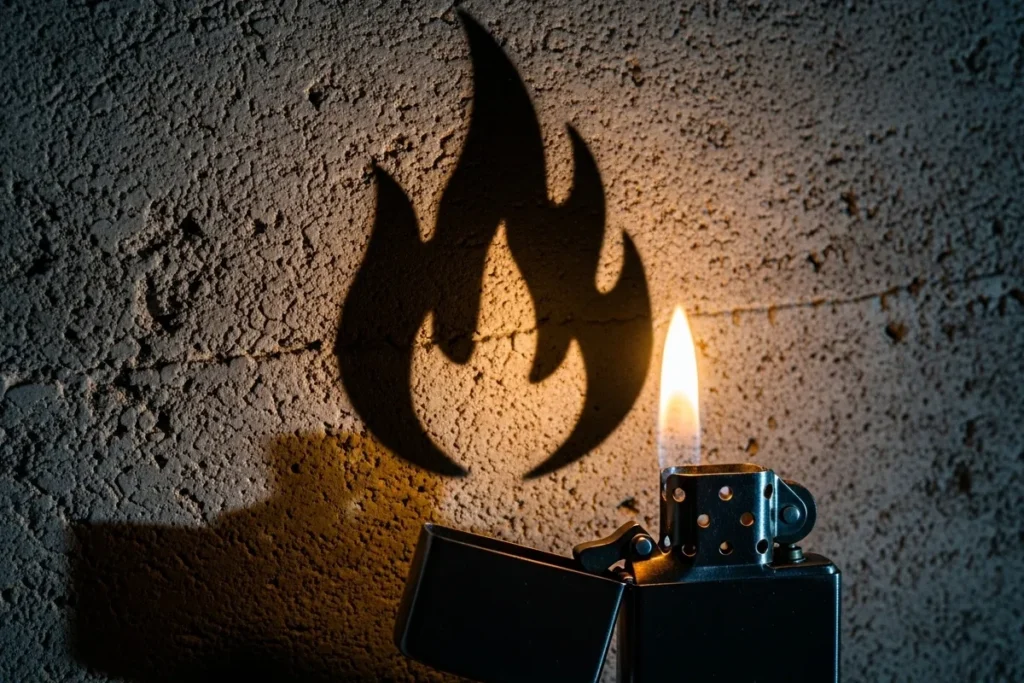Discover the fascinating evolution of lighters from their ancient origins to modern innovations. This blog explores the lighter’s role in igniting rebellion and expressing individuality in music, cinema, and cultural movements. Learn how this simple tool has transformed into a significant symbol of defiance and personal expression, while also adapting to contemporary values of sustainability and technology. From the iconic Zippo to the rise of electric lighters, explore the enduring legacy of the lighter and its multifaceted role within society.
Table of Contents
Introduction: The Evolution of the Lighter
The lighter, a device primarily designed for igniting flames, has undergone a remarkable transformation since its inception. Its history dates back to ancient civilizations, where rudimentary methods such as striking flint or using a simple fire drill were the primary means to create fire. The quest for a more efficient ignition method ultimately led to the development of modern lighters in the 19th century, specifically with the invention of the first friction-based lighter by the German chemist Johann Wolfgang Döbereiner in 1823. This innovation marked a significant shift in fire-starting technology.
Over the decades, the lighter evolved further, giving rise to various types that catered to different needs and preferences. The introduction of the cheaper, easily disposable butane lighter in the 20th century revolutionized the market, making it accessible to the masses. These lighters became widely popular due to their convenience and portability. The iconic Zippo lighter, designed in 1932, carved out a niche for itself as a reliable and iconic accessory, becoming synonymous with elements of rebellion and individuality.
This evolution from simple ignition devices to sophisticated tools has cemented lighters not only as practical items but also as powerful cultural symbols. They have found their way into the hands of figures in popular culture, often representing an ethos of defiance or a statement of identity. Lighters have been featured in music, literature, and film, embodying a spirit of rebellion and liberation through their symbolism. As we delve deeper into the cultural significance of lighters, it is essential to recognize their multifaceted role within society, transcending their original functionality to embody a unique expression of human experience and identity.
The Birth of the Modern Lighter
The modern lighter, an essential tool for starting fires, underwent significant evolution during the early 20th century, marked by pivotal innovations that transformed it into a popular and accessible device. The introduction of the flint lighter in the 1920s represented a groundbreaking advancement in ignition technology. This design utilized a small piece of flint, which, when struck against steel, produced the necessary spark to ignite the fuel. This method not only improved reliability but also enhanced the user experience, as it facilitated quick and easy fire-starting capabilities, thus making it a staple for many individuals.
In 1932, the introduction of the Zippo lighter by George G. Blaisdell further revolutionized personal ignition devices. The Zippo was designed with windproof features and a sturdy metal casing that allowed it to be used in various conditions. Its durability and ease of refilling appealed to consumers, making it an iconic symbol of American culture. The sleek, functional design of the Zippo lighter not only catered to practical needs but also created a sense of personal expression, as users began to customize their lighters with engravings and designs. This customization aspect spurred a new trend in which lighters became collectible items, thus enhancing their cultural significance.
The commercialization of these innovative lighters made them widely available to the general public. Advertising campaigns highlighted the convenience and reliability of flint lighters and Zippos, establishing them as must-have accessories. With the rise of credit systems, consumers could easily purchase these devices, leading to unprecedented levels of ignition device penetration in everyday life. As the 20th century progressed, these lighters not only served functional purposes but also became emblematic of rebellion and individualism, further solidifying their place in popular culture.

The Lighter and Rebellion: A Symbol of Defiance
The lighter has transcended its utilitarian purpose, evolving into a powerful symbol of rebellion and defiance throughout various historical contexts. From the flickering flames of a lighter emerged a rich tapestry of symbolism, showcasing humanity’s relentless quest for freedom and autonomy. A notable instance is seen in the 1960s, where lighters became staples at protests, epitomizing resistance against established norms, especially during events advocating for civil rights and anti-war movements. The iconic image of protesters lighting lighters in solidarity represents a collective desire for change, often igniting passion among onlookers.
This phenomenon continued into more modern contexts, where lighters emerged as tools of expression during pivotal movements around the globe. For instance, during the Arab Spring, the lighter was frequently depicted in demonstrations, conveying not only a demand for political reform but also individual empowerment. When held aloft during chants, the lighter acted as a beacon of hope and persistence. Its flame embodied the spirit of those clamoring for democracy and human rights, showcasing the lighter’s unique ability to resonate deeply within the human experience.
Moreover, lighters have played pivotal roles in various cultural artifacts, further solidifying their association with rebellion. Films and music often incorporate lighters as symbols of breaking free from societal constraints, capturing the essence of youthful defiance. Icons of rock and punk music have frequently used lighters in performances, invoking a sense of unity and shared resistance among fans. In such settings, the lighter is more than a mere object; it serves as a manifestation of collective identity, underscoring the importance of self-expression and the fight against oppression.
As we explore the historical significance of the lighter in the context of rebellion, it becomes evident that this small yet powerful object continues to hold meaning in moments of protest and defiance, captivating the imagination and encouraging movements for change across generations.
The Lighter in Music: A Cultural Icon
The lighter has emerged as an enduring symbol within the music culture, particularly in genres such as rock, punk, and hip-hop. This small yet powerful object has transcended its practical function to become a representation of rebellion, unity, and emotional expression during live performances. From the electrifying atmosphere of rock concerts to the spirited gatherings of punk shows, lighters have played a pivotal role in creating a sense of collective experience among fans.
One notable instance highlighting the cultural significance of lighters is during the live performances of iconic rock bands. During the 1970s and 1980s, it was common to witness thousands of lighters illuminating the crowd while anthems like “Hey Jude” by The Beatles or “Stairway to Heaven” by Led Zeppelin reverberated through the air. The sight of flickering flames created a visual spectacle that not only showcased the shared passion of the audience but also transformed concerts into communal celebrations of music and rebellion.
In the punk genre, lighters serve a similar purpose, acting as a unifying symbol during high-energy performances. The illuminated flames of lighters often rise above the audiences, embodying the spirit of defiance prevalent in punk culture. Songs like “Anarchy in the U.K.” by the Sex Pistols bring massive crowds together under a shared banner of resistance, with fans holding up their lighters as a gesture of solidarity and rebellion against societal norms.
Furthermore, in hip-hop, where individual expression reigns supreme, lighters have become a staple during concerts and festivals. Tracks that encourage participation often see fans igniting their lighters to create a shared ambiance with the artists on stage. This interaction not only highlights the engagement between performers and their audience but also reinforces the communal experience of music, symbolizing both personal freedom and collective rebellion.

The Lighter in Cinema: Capturing the Spirit of Rebellion
The representation of the lighter in cinema serves as a powerful symbol of rebellion and transformation. Throughout film history, this seemingly mundane object has been used to convey profound emotional depth and cultural commentary. Its flickering flame often ignites pivotal moments for characters, making it a visual cue for defiance against societal norms. From classic films to modern blockbusters, the role of the lighter transcends its practical use, capturing the spirit of resistance that resonates with audiences.
One striking example can be found in the iconic film “The Breakfast Club,” where a lighter is used during a moment of vulnerability among the characters. As they gather in a high school detention room, the act of lighting a cigarette signals a break from conformity. This scene embodies the teenage struggle against authority, illustrating how the lighter becomes an instrument for expressing rebellion against an oppressive environment. The characters find solace in their shared defiance, which is poignantly punctuated by the lighter’s flame.
Similarly, in “Fight Club,” a lighter serves as a catalyst for transformation. When the narrator ignites a cigarette, it symbolizes his emergence from the constraints of modern consumerism into a world of chaos and liberation. The lighter’s flame reflects his internal struggle and desire for self-discovery, serving as a potent metaphor for the reclamation of personal identity. As the plot unfolds, the lighter continues to appear, reinforcing its significance in the character’s journey towards rebellion.
Moreover, “Rebel Without a Cause” features the lighter prominently during key moments, reinforcing the theme of youthful defiance. The connection between the lighter and the characters’ emotional states highlights the role of this object as more than just a tool; it becomes a lifeline for expressing inner turmoil and aspirations for change. In conclusion, the use of the lighter in cinema reflects the larger narratives of rebellion, providing a compelling visual motif that resonates with viewers and illustrates the transformative power of personal and collective defiance.
The Lighter as a Fashion Statement
Over the years, lighters have evolved beyond their original utilitarian purpose of igniting flames; they have transformed into significant fashion statements within various subcultures. The emergence of designer lighters has created a niche market where style and functionality coexist. High-end brands have recognized the lighter as a canvas to showcase their creativity, resulting in luxury pieces that appeal to fashion enthusiasts. These designer lighters often feature unique designs, premium materials, and intricate details, turning them into collectible items and symbols of prestige.
Moreover, lighters have been embraced by numerous subcultures, serving as a means of self-expression among individuals. For instance, in the punk rock scene, customized lighters with graphic designs, slogans, or band logos become a form of rebellion, allowing individuals to showcase their artistic preferences or political beliefs. Similarly, the hip-hop culture has seen lighters become an essential accessory, often flaunted during performances or in music videos, elevating their status from mere convenience to stylish statement pieces.
The trend of using lighters as fashion accessories is not limited to specific subcultures alone. Many people now carry unique or personalized lighters as a reflection of their individuality, finding ways to express their personal style through these often-overlooked items. Custom engraving, artistic prints, and even alternative shapes contribute to this trend, allowing users to select lighters that resonate with their tastes. As a result, the lighter has carved out an important role in the fashion landscape, appearing in photo shoots, as part of street fashion, and even gracing the pages of lifestyle magazines.
In essence, the lighter has transcended its expected functionality, becoming intertwined with fashion and culture. Its ability to signify identity and style has cemented its position as more than just an accessory, but rather a statement of one’s aesthetics and values in today’s world.

Lighters in Revolutionary Movements
Throughout the 20th century and into the present day, lighters have evolved into powerful symbols of protest and solidarity within revolutionary movements worldwide. From the civil rights struggles in the United States to the anti-apartheid fight in South Africa, these small devices have transcended their original function, becoming tools of expression and unity among activists. The act of lighting a lighter can evoke powerful emotions, mediate communal moments, and serve as a form of defiance against oppression.
In the heart of various protests, lighters have often been seen illuminating the night, symbolizing hope and determination. One prominent example occurred during the 1960s in the United States, where lighters sparked flames at sit-ins and demonstrations, manifesting the demand for equality and justice. Protesters would light their lighters not only as a means of signaling their presence but also to create a visual impact, illustrating the collective resolve against systemic injustices.
Similarly, during the anti-apartheid movement in South Africa, lighters became synonymous with the struggle for freedom. Activists used them in gatherings to communicate their resolve, further emphasizing the fight against an oppressive regime. The flame produced by lighters symbolized resilience, urging individuals to stand united against discrimination and inequality. This duality of the lighter as a tool for rebellion and a beacon of hope significantly underscores its role in various cultural contexts.
In more recent times, lighters have again made their presence felt in global revolutionary movements, such as protests in Hong Kong and the Black Lives Matter movement. Participants often utilize lighters in creative displays of solidarity—by igniting candles or holding them aloft during marches. Such actions resonate across societies, showcasing the lighter’s unique ability to foster unity and defiance, while also connecting individuals through shared experiences of struggle.
The Future of the Lighter: From Ignition to Innovation
The lighter, an accessory that has transcended its primary purpose of providing flame, is on the verge of a transformative evolution driven by sustainability and technological advancement. As society increasingly prioritizes eco-friendly practices, the conventional lighter is facing competition from innovative designs that replace traditional fuels with electric alternatives. Electric lighters operate using rechargeable batteries, emitting no harmful fumes and significantly reducing waste. This shift not only aligns with a growing consciousness for environmental stewardship but also highlights a modern form of rebellion against conventional norms in smoking culture.
Furthermore, the introduction of eco-friendly materials in lighter manufacturing is gaining traction. Manufacturers are now exploring biodegradable plastics and refillable designs, ensuring the lighter’s lifecycle minimizes its environmental impact. These changes resonate with a demographic that values sustainability, thus perpetuating the lighter’s status as a symbol of rebellion against the disposable culture prevalent in today’s society. The combination of innovation and sustainability creates a new narrative—one that advocates for individualism and ecological responsibility simultaneously.
As technology progresses, future lighters may adopt smart features. Imagine devices that sync with mobile applications, providing data on usage patterns or reminding users to recharge. Such advancements would seem to resonate with modern consumers who appreciate efficiency and personalization. These electric lighters can also offer enhanced safety features, allowing users to enjoy their flames while minimizing risks associated with traditional gas lighters.
In conclusion, the future of lighters appears bright as they evolve from mere ignition tools to symbols of innovation and sustainability. This evolution not only reflects changing consumer preferences but also signifies a broader cultural shift towards responsible rebellion. With advancements paving the way, the humble lighter will continue to hold a significant place within popular culture.
Conclusion: The Enduring Legacy of the Lighter
The lighter, a seemingly simple tool for creating fire, has evolved to become a powerful symbol within popular culture and history. Throughout this blog post, it has been established that the lighter carries connotations that go beyond its practical use. Its role in igniting rebellion can be traced through various cultural movements that have embraced the act of lighting a cigarette or a flame as a defiance against societal norms. From its use in protests to its depiction in films and music, the lighter has consistently represented themes of individuality and resistance.
Moreover, the lighter’s design and versatility have allowed it to resonate with different generations. Iconic brands and unique designs have transformed lighters into collectible items, often serving as expressions of personal identity and style. Artists and musicians have frequently utilized lighters in their work to convey a sense of freedom or nonconformity, effectively solidifying its reputation as an accessory for rebels.
The lighter’s impact on popular culture extends further, infiltrating various aspects of daily life and becoming a shared object among diverse groups. Its presence at gatherings, celebrations, and candid moments signifies a common bond that transcends immediate differences. As a cultural artifact, the lighter has also inspired discussions surrounding safety and environmental concerns, leading to innovations such as refillable and eco-friendly alternatives that maintain the spirit of rebellion while addressing practical issues.
In essence, the enduring legacy of the lighter rests on its ability to symbolize both rebellion and cultural identity. The significance of this object persists, continually reminding us of the intersection between everyday objects and the broader narratives of society. As we reflect on the lighter’s role in shaping popular culture, it becomes clear that this small device embodies a rich tapestry of human expression and defiance, securing its place in both history and contemporary life.







